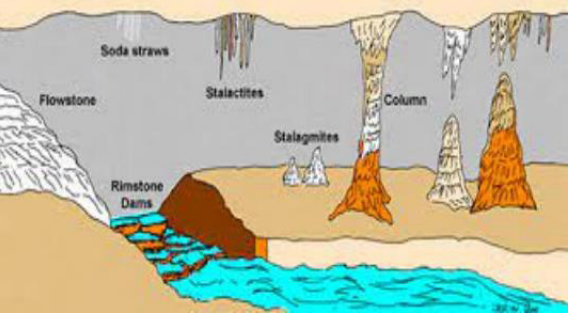
Speleothems, derived from the Greek words “spelaion” (cave) and “thema” (deposit), represent a fascinating array of mineral formations that adorn the hidden realms of caves and underground spaces. These geological features result from the deposition of minerals carried by water, typically in the form of dripping or flowing calcite-rich solutions. Speleothems come in diverse shapes and sizes, showcasing the intricate dance between water and rock within subterranean landscapes. Stalactites, stalagmites, columns, draperies, and helictites are among the myriad formations that contribute to the mesmerizing beauty of these underground worlds. Each speleothem type tells a unique geological story, offering insights into the processes that shape the hidden wonders of the Earth’s interior. In this exploration, we delve into the various forms and features of speleothems, unraveling the geological processes that transform seemingly ordinary caves into stunning natural galleries.
Contents
Answer
A “speleothem” is a mineral deposit that forms in caves or underground environments through the precipitation of minerals from groundwater, typically found in limestone and other soluble rocks where water can percolate through the rock, dissolve minerals, and then re- deposit them within the cave as the water drips or flows. Various Forms and Features of Speleothems are as follows:
- Stalactites
- Stalactites hang from the ceiling of caves and are formed when water drips from above, leaving behind mineral deposits.
- Have a cone-like shape, with water dripping slowly to add layers of minerals.
- Stalagmites
- Grow upward from the cave floor, as the mineral-laden water drips onto the ground and deposits minerals over time.
- Column
- Created when a stalactite and a stalagmite grow together, forming a solid mineral pillar that connects the cave ceiling to the floor.
- Helictites
- Helictites are unusual and often delicate formations that appear to defy gravity.
- Grow in various directions, twisting and turning due to the capillary action of water moving through porous rock.
- Cave Bacon or Curtains
- Cave bacon or curtains are wavy, ribbon-like formations that often occur in layers on cave walls.
- Result from alternating layers of mineral-rich water flow and dry periods.
Speleothems are valuable to scientists and cave enthusiasts as they can provide insights into past climate conditions and the history of underground environments.

In case you still have your doubts, contact us on 9811333901.
For UPSC Prelims Resources, Click here
For Daily Updates and Study Material:
Join our Telegram Channel – Edukemy for IAS
- 1. Learn through Videos – here
- 2. Be Exam Ready by Practicing Daily MCQs – here
- 3. Daily Newsletter – Get all your Current Affairs Covered – here
- 4. Mains Answer Writing Practice – here

